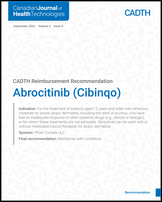|
Type of economic evaluation
| Cost-utility analysis Decision tree/Markov model hybrid |
|
Target population
| Adults and adolescents (≥ 12 years) with moderate to severe AD who have had an inadequate response to prescribed topical therapies, or for whom these treatments are not advisable; patients are assumed to have had no prior use of immunosuppressants (IMMs) |
|
Treatments
| ABRO 100 mg + SoC ABRO 200 mg + SoC |
|
Submitted price
| ABRO, 50 mg, 100 mg: $48.67 per tablet ABRO, 200 mg: $54.47 per tablet |
|
Annual treatment cost
| ABRO 100: $17,765 ABRO 200: $19,882 |
|
Comparators
| SoC (comprised of a basket of topical corticosteroids, topical calcineurin inhibitors, phosphodiesterase type 4 inhibitors, oral antihistamines) DUP + SoC CYC + SoC MTX + SoC |
|
Perspective
| Canadian publicly funded health care payer |
|
Outcome
| QALYs |
|
Time horizon
| Lifetime (up to patient age 110 years) |
|
Key data source
| Treatment inputs for ABRO were informed by JADE COMPARE, JADE EXTEND, JADE MONO-1, JADE MONO-2, JADE TEEN, and JADE DARE. A network meta-analysis was used to compare effectiveness of ABRO vs. DUP and SoC; comparative effectiveness for MTX and CYC was based on an unanchored MAIC. |
|
Key limitations
|
The pharmacoeconomic evaluation of ABRO may not reflect its clinical use in the following aspects: 1) the target population of the sponsor’s base case (patients eligible for systemic IMMs) is not aligned with the indication or the anticipated place of ABRO in therapy (among those refractory or ineligible for IMMs); 2) the clinical expert consulted by CADTH for this review indicated that most patients will start treatment on ABRO 200, potentially stepping down to ABRO 100 depending on treatment response and adverse events. Treatment adherence, which would be expected to impact both costs and health outcomes, is not considered in the sponsor’s model. Clinical expert feedback suggested that adherence would be lower among patients taking ABRO compared to DUP, owing to the mode of administration. Relevant comparators, such as some IMMs, retinoids, and phototherapy were not considered. Additionally, the comparative effectiveness data from the sponsor’s MAIC for methotrexate and cyclosporine is highly uncertain. The use of clinical effectiveness data assessed at 16 weeks of treatment may overestimate the incremental effectiveness of ABRO compared with DUP, owing to a longer onset of effect for DUP. The use of 16-week outcome data may bias the ICER in favour of ABRO. The health state utility values adopted by the sponsor are highly uncertain and lacked face validity. The long-term efficacy of ABRO is unknown. Treatment discontinuation and effectiveness waning for ABRO, both influential factors in the economic analysis, were based on assumptions that were not supported by trial data. The sponsor assumed that the impact of adverse events would be captured by health state utility values. The model did not include all adverse events deemed important by clinical experts consulted for this review. The utility measure chosen for the analysis likely does not capture health changes due to adverse events identified by patients and the clinical expert as being highly relevant. The cost-effectiveness of ABRO in an adolescent population is uncertain. The sponsor’s model assumed a cohort starting age of 29 years. The sponsor’s NMA was based on adult patients, and assumptions were required about the relative effectiveness of treatments among adolescents. Treatment adherence, which was not considered in the model, may vary between adults and adolescents. The sponsor’s model employed poor modelling practices, preventing CADTH from fully validating the model and its findings.
|
|
CADTH reanalysis results
|
CADTH reanalyses included: assuming that ABRO will be used by patients who are refractory or ineligible for systemic IMMs, removing MTX and CYC as comparators; assuming that health state utility values are equal, regardless of which treatment is received; assuming the utility benefit for treatment response starts at 8 weeks for all treatments; and assuming that treatment effectiveness will wane over the entire analysis horizon. CADTH was unable to address the lack of comparative clinical effectiveness data for some relevant treatment comparators, the impact of treatment adherence and adverse events, and the lack of long-term treatment efficacy data beyond 52 weeks. The comparative effectiveness of all comparators is highly uncertain beyond 16 weeks. Consequently, the results of the economic analysis are highly uncertain. CADTH noted that the results are highly dependent on the price of DUP. CADTH was additionally unable to address the cost-effectiveness of ABRO among patients who have had an inadequate response to biologics. The estimated ICERs from the CADTH reanalysis were higher than those submitted by the sponsor: A key scenario analysis was conducted to reflect clinical practice as anticipated by clinical experts, who suggested that adult patients would initiate treatment with ABRO 200. In patients with refractory or ineligible for systemic IMMs, where ABRO 100 + SoC was removed from the analysis, the ICER for ABRO 200 + SoC compared to SoC is $177,248 per QALY (DUP was dominated by ABRO 200 + SoC).
|
